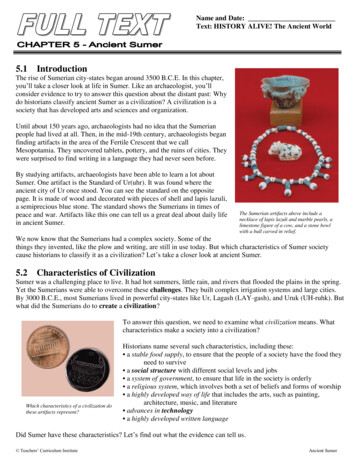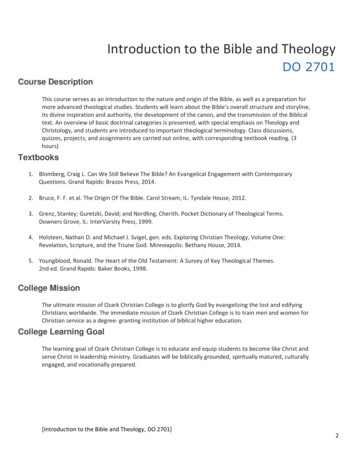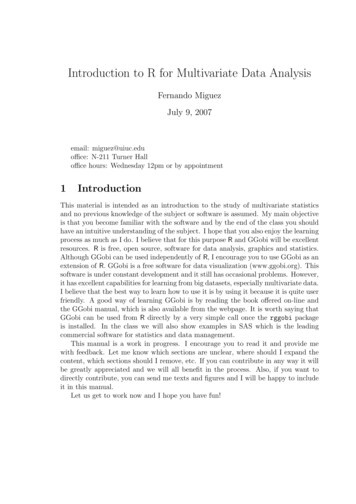
Transcription
Name and Date:Text: HISTORY ALIVE! The Ancient World5.1IntroductionThe rise of Sumerian city-states began around 3500 B.C.E. In this chapter,you’ll take a closer look at life in Sumer. Like an archaeologist, you’llconsider evidence to try to answer this question about the distant past: Whydo historians classify ancient Sumer as a civilization? A civilization is asociety that has developed arts and sciences and organization.Until about 150 years ago, archaeologists had no idea that the Sumerianpeople had lived at all. Then, in the mid-19th century, archaeologists beganfinding artifacts in the area of the Fertile Crescent that we callMesopotamia. They uncovered tablets, pottery, and the ruins of cities. Theywere surprised to find writing in a language they had never seen before.By studying artifacts, archaeologists have been able to learn a lot aboutSumer. One artifact is the Standard of Ur(uhr). It was found where theancient city of Ur once stood. You can see the standard on the oppositepage. It is made of wood and decorated with pieces of shell and lapis lazuli,a semiprecious blue stone. The standard shows the Sumerians in times ofpeace and war. Artifacts like this one can tell us a great deal about daily lifein ancient Sumer.The Sumerian artifacts above include anecklace of lapis lazuli and marble pearls, alimestone figure of a cow, and a stone bowlwith a bull carved in relief.We now know that the Sumerians had a complex society. Some of thethings they invented, like the plow and writing, are still in use today. But which characteristics of Sumer societycause historians to classify it as a civilization? Let’s take a closer look at ancient Sumer.5.2Characteristics of CivilizationSumer was a challenging place to live. It had hot summers, little rain, and rivers that flooded the plains in the spring.Yet the Sumerians were able to overcome these challenges. They built complex irrigation systems and large cities.By 3000 B.C.E., most Sumerians lived in powerful city-states like Ur, Lagash (LAY-gash), and Uruk (UH-ruhk). Butwhat did the Sumerians do to create a civilization?To answer this question, we need to examine what civilization means. Whatcharacteristics make a society into a civilization?Which characteristics of a civilization dothese artifacts represent?Historians name several such characteristics, including these: a stable food supply, to ensure that the people of a society have the food theyneed to survive a social structure with different social levels and jobs a system of government, to ensure that life in the society is orderly a religious system, which involves both a set of beliefs and forms of worship a highly developed way of life that includes the arts, such as painting,architecture, music, and literature advances in technology a highly developed written languageDid Sumer have these characteristics? Let’s find out what the evidence can tell us. Teachers’ Curriculum InstituteAncient Sumer
Name and Date:Text: HISTORY ALIVE! The Ancient World5.3Stable Food SupplyCivilizations need a stable food supply. A complex societycan thrive only if its members have the food they need tosurvive.The Sumerians invented two key things to help them create astable food supply. One of these inventions was theircomplex irrigation systems. The Sumerians built networksof canals, dams, and reservoirs to provide their crops with aregular supply of water.Their second invention was the plow. A plow is a tool usedfor tilling, or turning, the soil to prepare it for planting.Before the plow was invented, farmers used animal horns orpointed sticks to poke holes in the earth. Then they wouldplant seeds in the holes. This was a very slow way to farm.Farmers needed a faster way to prepare the land for planting.The Sumerians invented the plow. Today, some people in Iraq,the present-day location of Sumer, still use plows to farm theland.The Sumerians made the first plow out of wood. One end of the plow was bent for cutting into the ground to turn thesoil. Farmers themselves pushed and pulled the plow along the ground, or they used animals such as oxen to pull it.5.4Social StructureCivilizations have a complex organization, or socialstructure. A social structure includes different jobs andsocial levels. People at higher levels have greater status thanothers.Archaeologists have found evidence that several classes ofpeople lived in Sumer. At the top level were priests,landowners, and government officials. These people had thelargest and most luxurious homes, near the center of thecity. Their houses were two stories high. Evidence suggeststhat these mud houses had whitewashed walls.This man and child are standing in the ruins of the ancient city ofUruk, located in present-day Iraq.At the middle level were merchants and artisans. Amongthe artisans were skilled metalworkers. They worked withsuch metals as gold, silver, tin, lead, copper, and bronze. Out of these materials, they made swords and arrowheadsfor the army. They made tools, like plows and hoes, for farmers. They also made luxury items, such as mirrors andjewelry, for the upper class.The middle class also included farmers and fishers They lived in small, mud-brick houses at the edge of the city.Farmers oft en worked to build or repair the irrigation systems. In times of war, they were forced to serve in the army.At the bottom level of the social structure were slaves. They lived in their owners’ homes and had no property of theirown. Teachers’ Curriculum InstituteAncient Sumer
Name and Date:Text: HISTORY ALIVE! The Ancient World5.5GovernmentAll civilizations have a system of government to direct people’s behavior and make life orderly. Sumerian city-stateswere ruled by kings. The Sumerians believed that their gods chose these kings. This belief made kings very powerful.It also helped to reinforce the social order, because obeying the will of the gods was one of the Sumerians’ strongestbeliefs.Sumerian kings enforced the laws and collected taxes. They built temples and made sure irrigation systems weremaintained.A king also led his city-state’s army. All the city-states needed armies because of constant fighting over landboundaries and the use of water. Leading the army was one of the king’s most important jobs.A Sumerian army included both professional soldiers and temporary citizen-soldiers. Some were foot soldiers.Others drove chariots, which were wheeled vehicles pulled by horses.Kings appointed officials to help with certain duties. Governors ruled the outlying towns. Scribes helped record laws.The Sumerians were the first people to develop a system of written laws.One special group of officials patrolled the canals. They looked for damage and made sure that farmers did not takewater illegally.5.6ReligionAll civilizations have some kind of religious system. A religious system includes both a set of beliefs, usually in agod or gods, and forms of worship.In Sumer, religious beliefs influenced every part of daily life. The Sumerians tried to please their gods in all things,from growing crops to settling disputes. Religion bound the people together in a common way of life.The ancient Sumerians expressed their religious beliefs by constructing temples and religious towers called ziggurats(ZIHG-guh-rats). It was the king’s duty to build and maintain these ziggurats. The towers were platforms made ofmud bricks, with shrines on the highest tier. Ziggurats were so large that they could be seen from 20 miles away.Some were as high as 8 stories and as wide as 200 feet.The Sumerians believed that their gods lived in the ziggurats, most likely in the special shrines at the top. Attached tothe outside walls of each ziggurat was a long staircase that the gods could use to climb down to Earth. Kings andpriests stood inside the towers to ask for the gods’ blessings.Sumerian statues also expressed religious beliefs. Many of these statues were detailed and lifelike. They showedpeople worshipping the gods, oft en with eyes gazing upward. The Sumerians believed that the gods were pleasedwhen people showed these signs of devotion, or love and obedience.The Sumerians had many kinds of religious ceremonies. Often, musicians played at these ceremonies. Someceremonies may have involved human sacrifice, the ritual killing of a person as an offering to the gods. Teachers’ Curriculum InstituteAncient Sumer
Name and Date:Text: HISTORY ALIVE! The Ancient World5.7The ArtsAll civilizations have a highly developed culture, including the arts. Arts include creative forms of expression suchas painting, architecture, and music.There were many kinds of artists and artisans in ancient Sumer. Metalworkers made objects, like weapons and cups.They made decorative items, such as mirrors and jewelry, too. Architects designed temples and ziggurats.Music was another important art in Sumer. The Sumerians believed that music brought joy to gods and people alike.Musicians sang and played instruments during temple ceremonies. They wrote love songs and entertained guests atfeasts.Sumerian musicians played a variety of instruments, including drums and pipes. One favorite was a small harp calleda lyre. Lyres were wooden instruments made of a sound box and strings. A wooden bar held the strings in place at thetop. Lyre makers often decorated their instruments with precious stones and with carvings made of horn. Thesedecorations show how much the Sumerians valued music.5.8TechnologyAll civilizations create new forms of technology. The Sumeriansmade several technological advances.The most important Sumerian invention was the wheel. Theearliest examples of the wheel date back to 3500 B.C.E. Sumerianpotters, or pottery makers, first used wheels as a surface forshaping clay into pots. Potters’ wheels spun, flat side up, on anaxle. The Sumerians discovered that a wheel that was flipped ontoits edge could be rolled forward. They used this discovery tocreate wheeled carts for farmers, and chariots for the army. Theybuilt the wheels by clamping pieces of wood together.It would be hard to discover a more powerful invention than theThis is a model of a wheeled chariot used in the Sumerianwheel. Before the wheel, people had to drag their goods on flatarmy. Chariots were pulled by horses or donkeys whilebottomed carts called sledges. The sledges often got stuck in mud,soldiers stood behind the shields.and they couldn’t support heavy loads. Wheeled carts made itmuch easier to move goods over long distances. Oxen could pull three times more weight on wheeled carts than onsledges.Another technological advance was the arch. Sumerian arches were inverted (upside-down) U- or V-shaped structuresbuilt above doorways. To build arches, the Sumerians stacked bricks, made of clay and straw, to rise from the wallsin steps until they met in the center.Arches added strength and beauty to Sumerian buildings. They became a common feature of temple entrances andupper-class homes. Some historians say that the arch is the Sumerians’ greatest architectural achievement. Teachers’ Curriculum InstituteAncient Sumer
Name and Date:Text: HISTORY ALIVE! The Ancient World5.9WritingA final characteristic of civilizations is a highly developedwritten language. The Sumerians created a written languagecalled cuneiform. This name comes from the Latin word for“wedge.” The Sumerians used a wedge-shaped stylus (a sharp,pointed tool) to etch their writing in clay tablets.Sumerians developed cuneiform around 2400 B.C.E. Theearliest examples of cuneiform show that it was used to recordinformation about the goods people exchanged with oneanother. At first, cuneiform writing may have contained asmany as 2,000 symbols to stand for ideas and sounds. Overtime, this number was reduced to about 700.Cuneiform was based on an earlier, simpler form of writing thatused pictographs. Pictographs are symbols that stand for realobjects, such as a snake or water. Scribes used a sharpened reedto draw the symbols on wet clay. When the clay dried, themarks became a permanent record.Shown here is cuneiform writing etched in a clay tablet.CHAPTER SUMMARYIn this chapter, you have learned about the characteristics of Sumer society that made it a civilization.Stable Food Supply Ancient Sumerians invented an irrigation system and the plow to help them create a stable foodsupply.Social Structure, Government, and Religion Ancient Sumer had a complex social structure with different jobs andsocial levels. The government was led by kings. Religious beliefs influenced every part of daily life.Arts, Technology, and Writing Ancient Sumerians had a highly developed culture that included the creative arts ofpainting, architecture, and music. The Sumerians’ most important technological invention was the wheel. They alsocreated a written language called cuneiform that was based on pictographs. Teachers’ Curriculum InstituteAncient Sumer
Text: HISTORY ALIVE! The Ancient World 5.7 The Arts All civilizations have a highly developed culture, including the arts. Arts include creative forms of expression such as painting, architecture, and music. There were many kinds of artists and artisans in ancient











